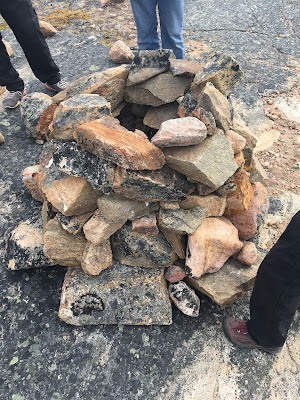 |
| CBC article about the race along the trail from Iqaluit to Kimmirut |
Every year there are snowmobile races from Iqaluit to Kimmirut and back. This can be quite dangerous. Although there have been no fatalities to date, it isn't unheard of for a snowmobile to fall into a ravine or get stuck in the ice. Last year's winning time clocked in at just over 2 hours. Given the race is 240km, that means 110km/h in a snowmobile (at times faster) going up and down mountains. That's nuts.
 |
| This guy totalled his snowmobile a kilometer outside of Iqaluit. You can read about it here: http://www.cbc.ca/news/canada/north/kimmirut-snowmobile-race-bobby-gordon-1.4074914 |
 |
| At Sylvia Grinnell Territorial Park. The pavilion is at the base of the hill. |
Today the family went to Sylvia Grinnell territorial park for Iqaluit's tiny celebration of the Great Trail. While lacking the "oompf" of the other festivities throughout the country (many of which included live music and big parties), the local celebration was a far more intimate gathering. About 9 people joined 3 park rangers and 2 Inuit elders in the park pavilion to learn and talk about the trail from Iqaluit to Kimmirut. The rangers served fresh blueberry leaf tea, as well as bearberry and saxifrage leaf tee, fresh from the oven bannock, and smoked arctic char.
 |
| Tea please. |
 |
| Loving bannock. |
 |
| Bannock with your choice of butter, jam, or peanut butter. |
 |
| My mother enjoying smoked arctic char. |
The elder spoke in Inuktitut, with a second elder translating into English. He told us stories about when he was a child traveling the trail to go hunting, and how his father used to deliver mail from Iqaluit to Kimmirut via the trail (which is still used for supplies today). It is also a recreational trail, used by tourists who come from around the world. They can either hike the entire trial, or fly into the mid-way point to raft or canoe down the Soper River. Locals travel the trail daily to trap foxes, hunt, and pick berries.
After the presentation/discussion about the trail, the park rangers taught us about Inuksuit. (Inuksuit is plural for "Inukshuk".) Inuit have historically been a nomadic people, without written language. Rocks were ingeniously used as a means of communication between people; with various formations pointing to danger, marking trails and indicating caches of food or supplies. They were also used to construct fox traps.
 |
| Tunnel fox trap constructed of rocks. |
 | |||
| Tower fox trap. The fox crawls up the side, jumps in, but can't jump back out. Like a lobster trap. Except for foxes. |
 | |
| Inukshuk. Looking through the middle opening directs your gaze to an area of significance, such as a cache of supplies. |
Up next: school is starting again! Will we survive the drama? Will the kids get to school on time? Stay tuned to find out.





No comments:
Post a Comment